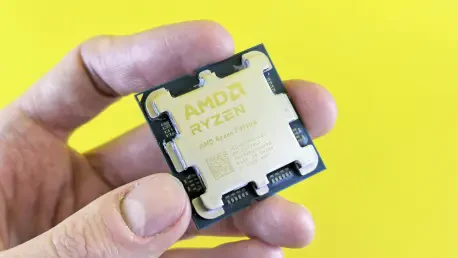In a rapidly evolving tech landscape, AMD has emerged as a formidable force, consistently pushing the boundaries of innovation with each strategic move, as recently showcased during its financial analysts’ day. The company’s roadmap reveals an ambitious vision that spans cutting-edge CPU architectures, powerful graphics solutions, and transformative AI technologies, all while navigating the delicate balance between its high-growth data center operations and the dynamic client computing market. From the confirmation of the Zen 7 architecture to the unveiling of future processor families like Gorgon and Medusa, AMD is clearly gearing up to solidify its position as a leader across multiple domains. Moreover, its advancements in GPUs and neural processing units (NPUs) signal a deep commitment to addressing modern computing demands. This comprehensive strategy not only highlights AMD’s technical prowess but also underscores its adaptability in a competitive industry, setting the stage for a future where performance and intelligence converge seamlessly.
Pushing CPU Boundaries with Zen 7
AMD’s CPU roadmap continues to captivate industry watchers with the official confirmation of Zen 7, the next evolutionary step following Zen 5, which drives the Ryzen 9000 series, and Zen 6, expected to power EPYC server processors later this year. Although specifics such as launch timelines or technical features remain undisclosed, the announcement of Zen 7 serves as a strong indicator of AMD’s relentless drive to maintain dominance in CPU performance. This is particularly significant in the desktop segment, where AMD already commands over 50% of the channel share, reflecting consumer trust and market strength. The focus on Zen 7 suggests a trajectory of sustained improvement, building on the architectural successes of its predecessors to deliver even greater efficiency and power for diverse computing needs, from personal devices to enterprise solutions.
A deeper look into AMD’s development strategy reveals a meticulous approach to CPU innovation, characterized by a staggered model where distinct teams alternate between architectural generations. This method ensures a continuous pipeline of advancements while allowing for specialized focus on both high-performance and energy-efficient designs. Such a structure is pivotal for addressing the varied demands of modern markets, spanning everything from desktop gaming rigs to cloud-based server environments. By maintaining this dual focus, AMD not only secures its competitive edge but also positions itself to adapt swiftly to emerging technological trends, ensuring that each new generation of processors meets the evolving expectations of users and industries alike.
Future Processor Families on the Horizon
Looking toward the coming years, AMD has teased the industry with codenames for its upcoming processor families, dubbed “Gorgon” and “Medusa,” which are slated for release in 2026 and 2027, respectively. These processors are anticipated to target the midrange notebook segment, as suggested by earlier leaks referencing names like “Gorgon Point.” This naming convention, often paired with suffixes such as “Point” or “Halo,” illustrates AMD’s strategic intent to segment its offerings for specific use cases, balancing affordability with robust performance. This approach ensures that AMD remains competitive across a spectrum of price points, catering to both casual users and those seeking premium capabilities in portable devices, thereby expanding its market reach.
Further insight into AMD’s processor strategy reveals a deliberate effort to tailor solutions for distinct market needs, ensuring that each product family serves a unique purpose. The introduction of Gorgon and Medusa highlights a forward-thinking plan to address the growing demand for versatile, mid-tier laptops that can handle everyday tasks alongside more intensive applications like content creation or light gaming. By structuring its roadmap with such precision, AMD demonstrates an acute awareness of consumer diversity, positioning itself to capture significant market share in segments that are often overlooked by competitors focusing solely on high-end or budget extremes. This nuanced segmentation could prove to be a game-changer in sustaining long-term growth.
Advancements in Graphics and AI Technologies
AMD is not resting on its laurels when it comes to graphics and AI, with promising developments in its GPU and NPU roadmaps signaling a robust push into these critical areas. While detailed specifications are yet to be disclosed, the company’s focus on enhancing desktop GPU performance is evident, alongside an exploration of edge computing applications that could redefine how graphics processing is integrated into compact systems. Simultaneously, AMD’s NPU efforts are centered on boosting Tera Operations Per Second (TOPS) metrics and improving power efficiency, aligning with the broader industry trend toward smarter, more sustainable devices. This dual emphasis reflects a comprehensive vision to embed advanced computational intelligence across all product lines.
Delving deeper, AMD’s commitment to AI integration stands out as a cornerstone of its technological evolution, aiming to transform how devices interact with users in both personal and professional contexts. The advancements in NPUs are particularly noteworthy, as they promise to deliver heightened AI capabilities without the heavy power draw typically associated with such processing. Meanwhile, GPU enhancements suggest that AMD is gearing up to challenge rivals in the desktop graphics arena, potentially offering gamers and creators tools that rival or surpass current market leaders. Together, these developments position AMD as a versatile contender, ready to meet the escalating demands of a world increasingly reliant on seamless graphics and intelligent computing solutions.
Strategic Focus: Data Centers and Client Computing
A defining theme from AMD’s recent announcements is the pronounced shift in corporate priorities toward data centers, now recognized as the primary revenue driver and deemed the most strategic segment by CEO Lisa Su. This focus has somewhat eclipsed the client computing division, as evidenced by the limited discussion time allocated to it during the financial analysts’ day. Despite this, AMD’s leadership remains steadfast in its commitment to the client market, emphasizing a “no compromise” approach to PC development. This stance highlights an intent to maintain strength in areas like gaming and AI-driven personal computing, even as resources are funneled into data center growth, illustrating a complex balancing act between immediate profitability and long-term consumer engagement.
Exploring this dynamic further, it becomes clear that AMD views its client computing portfolio as a vital area for innovation, particularly in the burgeoning fields of AI PCs and gaming hardware. Senior leadership has articulated a vision of leading the era of intelligent personal devices, suggesting that while data centers may dominate current revenue streams, the client segment is seen as a key frontier for future expansion. This optimism is tempered by the reality of resource allocation, where the strategic importance of data centers could potentially slow the pace of consumer-focused breakthroughs. Nevertheless, AMD’s ability to juggle these dual priorities will likely determine its success in maintaining a holistic presence across both enterprise and individual markets in the years ahead.
Reflecting on AMD’s Path Forward
Reflecting on AMD’s unveiled strategies, it’s evident that the company navigated a pivotal moment with its announcements, skillfully blending its legacy in CPU excellence with bold strides into AI and graphics domains. The confirmation of Zen 7, alongside the introduction of future processors like Gorgon and Medusa, cemented AMD’s dedication to sustained technological leadership. Meanwhile, the emphasis on data centers, though dominant, did not fully overshadow the innovative spirit driving client computing advancements. Looking ahead, stakeholders can anticipate AMD leveraging its data center strength to fuel research and development in consumer technologies, potentially accelerating AI integration in everyday devices. Additionally, keeping a close watch on how AMD balances these priorities will be crucial, as it could shape the accessibility and impact of next-generation computing solutions for diverse audiences.









